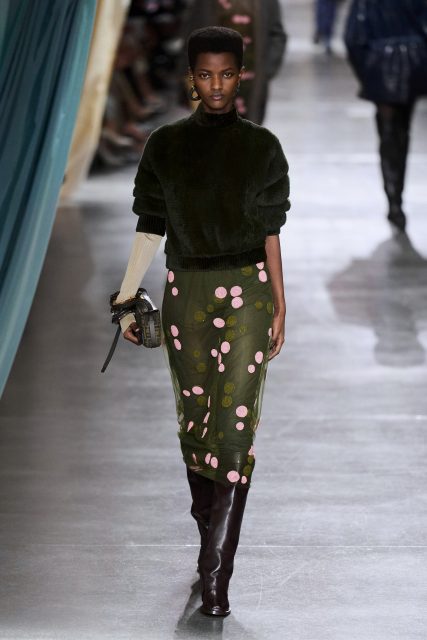“One nice thing about this concept is that it breaks the ‘holiness’ from the show. There’s always that thing where you can’t see anything until it’s on the runway.” So said Glenn Martens during a preview of this collection that—as Vogue Business (go read it) comprehensively reported earlier today—was really kind of a post-view: this was because the final preparations for this morning’s show had been streamed non-stop from Diesel’s Via Stendhal HQ for the last four days.
Demystifying the fashion show is completely consistent with Martens’s increasingly assured captaincy of Diesel. “We are always trying to be alternative in the industry. We belong in Fashion Week, but we are not a classic luxury brand; we are all about lifestyles. And we are about our communities and our friends and our families—so let’s try and bring them in.”
This was why when Martens’s impressive wax-matted braid knitwear pieces were walked in front of me I found myself borderline ignoring them. Instead I was watching a beautifully-snouted long-haired hound—I wouldn’t like to unintentionally misbreed, but he/she appeared Afghan—who stared forth from just one cell on of the six enormous 100-cell Zoom call screens that were placed extremely close to the IRL audience. Other Zoomers who had registered to participate thus in the show included someone in an alien suit who was suspiciously on-brand in a big-D Diesel hat, someone whose monumental embonpoint filled their screen, and another regrettably less focused dog. A few looks near the end, including the tank top worn by model Dieselboy (yes, really), were printed with more Zoom screens to add an extra-meta twist to this postmodern hall of mirrors matrix.
The clothes were as crazily layered, intensely worked and repeatedly stimulated as Diesel’s core audience. As transparent as his acid washed sweat-stain jerseys, or gauze clad “cauliflower” puffer jackets, Martens had in the preview cheerily called my attention to Faustine Steinmetz, who has acted as freelance designer for all Diesel artisanal pieces for the last four seasons. Really impressive were the synthetic hair edged destroyed argyles, and the tufted knits in layers of patched color designed to resemble friction-worn vintage pieces. A similar intention was behind the mixed-length faux furs. Denim, knit and jersey were all burned and then subjected to willfully anarchic forms of reconstruction surgery to create beautiful mixed-up Frankensteins: paragons of purposefully imperfect luxury. After Martens came out, the Zoom screens rippled with goodbye wave icons and the cells of Diesel’s alternative front row goers blinked off. That rapt fashion dog was one of the last to end the call. Diesel recently reported a significant uplift in revenues for 2023, and little wonder: as well as his design chops, Martens’s instinct for brand image optimization is off the hook.
Read Next
Rome, Romance, The New Romantics: Kim Jones Fashions A Fendi Love Story
Editor
Luke LeitchCredit
Lead image: Filippo Fior / Gorunway.com

